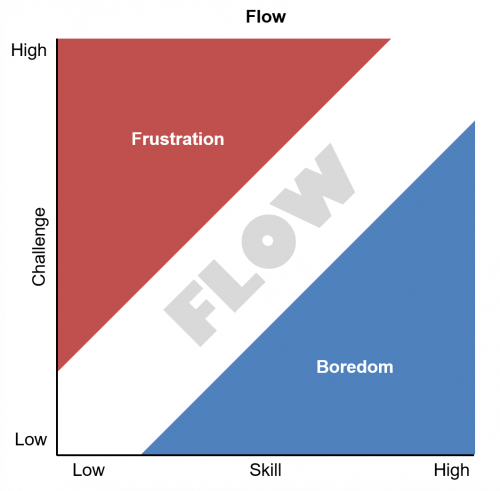In gamification, we often speak about Mihály Csíkszentmihályi’s Flow, a quick search of my site will bring up more than few posts on the topic. However, as I have pointed out before, we are not really talking about Flow but rather “Optimal Experience”.
We speak about one very specific part of Flow, that of balancing challenge against skill. As a quick refresher, one of the key conditions for Flow to occur is the perceived level of challenge must not exceed or fall below the persons perceived level of skill. If it exceeds it, the person will become frustrated at the difficulty. If it falls below, they will quickly become bored.

This balance point is what we refer to as Flow. However, if you look at the true definition of Flow, it is a combination of several other factors we are not considering [1].
- One must be involved in an activity with a clear set of goals and progress. This adds direction and structure to the task.
- The task at hand must have clear and immediate feedback. This helps the person negotiate any changing demands and allows them to adjust their performance to maintain the Flow state.
- One must have a good balance between the perceived challenges of the task at hand and their own perceived One must have confidence in one’s ability to complete the task at hand.
As we can see, the skill/challenge concerns are just one of three key ingredients that need to be present for true Flow to occur. The good news is gamification is great for delivering both goals and feedback. However, that is not all there is too it. Whilst those are the things needed in the system, Flow is a mental state for the person in the system and there are some very specific factors they must experience in combination to be considered in Flow [2]
- Intense and focused concentration on the present moment
- Merging of action and awareness
- A loss of reflective self-consciousness
- A sense of personal control or agency over the situation or activity
- A distortion of temporal experience, one’s subjective experience of time is altered
- Experience of the activity as intrinsically rewarding, also referred to as autotelic experience
Optimal Experiences
As great as gamification is, I am yet to see case studies that prove people in a pure gamification system experience these in combination! So, can we truly say gamification induces Flow?
As gamification designers, Flow is a key aim for our systems, it is (As Roman Rackwitz put it) the Champion League of goals for engagement. However, most, if not all the time, we are not in this league of engagement – that is reserved for true games. Gamification should be considered a Premier League engagement player, due to its very nature and the nature of what it is being applied to! This is not a criticism, more a clarification.
Definitely. Totally agree 🙂 To achieve Flow is Championsleague. We should cheer if we can play premier league 😉 experience it is
— Roman Rackwitz (@RomanRackwitz) September 25, 2017
What we should be talking about is “Optimal Experiences”. Whilst we are aiming for Flow, we are creating systems that are well balanced for our users, keep skill and challenge balanced, offer good feedback and provide well-structured goals.

References
[1] M. Csikszentmihalyi, S. Abuhamdeh, and J. Nakamura, “Flow.,” in Handbook of competence and motivation., 2005, pp. 598–608.
[2] J. Nakamura and M. Csikszentmihalyi, “Flow theory and research,” Oxford handbook of positive psychology. pp. 195–206, 2009.
On the thought of Feedback, here is the last slide deck on my 4 core principles of gamification!
Similar Posts:
- Flow & gamification: a misunderstanding
- Stop Using Flow as an Objective in Gamification
- Introduction to Gamification Part 7: Rewards and Reward Schedules


Also published on Medium.


Keep them curious and busy! I still wonder how to measure this!